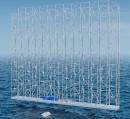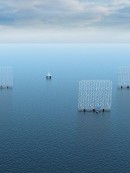Humanity is in desperate need of new energy sources if our species wants to continue enjoying this planet we like to call home. Ocean wave energy has a great potential to fulfill that need in some parts of the globe, but we’ve been barely scratching the surface when it comes to harvesting the power of this source. Now a promising technology might help us double that power.
Wave energy is a clean, reliable source, and the best thing about it is that is available to us 90 percent of the time, as suppose to wind and solar, which are only available 20 to 30 percent of the time, but even so, they seem to be in the lead on the renewable market.
A team of researchers has come up with a wave energy converter that claims it’s twice as efficient at harvesting power from ocean waves compared to any similar technologies developed so far. It happened at the RMIT University in Melbourne, Australia (which has more than 21,700 miles/35,000 km of coastline), where the engineers led by Professor Xu Wang developed a prototype dual-turbine wave energy conversion technology.
Wave energy is most commonly harvested using something called a buoy-type converter, which is also known as a point absorber. It uses the up and down movement of the waves to harvest the energy, being precisely synchronized with their movement, through an array of sensors, actuators, and control processors. It is a complex technology that can often be unreliable and hard to maintain.
The device created by the RMIT researchers doesn’t need all the techy additions, as it floats naturally up and down the swell of the waves, staying in sync with their movement, as explained by Xu Wang. It uses dual turbine wheels that are connected to a generator and are stacked on top of each other, rotating in opposite directions.
RMIT’s prototype maximizes the energy that’s harvested, doubling it compared to other point absorber technologies. So far, the researchers have only tested the system in the lab but they now plan to use a full-scale model for further tests.
A team of researchers has come up with a wave energy converter that claims it’s twice as efficient at harvesting power from ocean waves compared to any similar technologies developed so far. It happened at the RMIT University in Melbourne, Australia (which has more than 21,700 miles/35,000 km of coastline), where the engineers led by Professor Xu Wang developed a prototype dual-turbine wave energy conversion technology.
Wave energy is most commonly harvested using something called a buoy-type converter, which is also known as a point absorber. It uses the up and down movement of the waves to harvest the energy, being precisely synchronized with their movement, through an array of sensors, actuators, and control processors. It is a complex technology that can often be unreliable and hard to maintain.
The device created by the RMIT researchers doesn’t need all the techy additions, as it floats naturally up and down the swell of the waves, staying in sync with their movement, as explained by Xu Wang. It uses dual turbine wheels that are connected to a generator and are stacked on top of each other, rotating in opposite directions.
RMIT’s prototype maximizes the energy that’s harvested, doubling it compared to other point absorber technologies. So far, the researchers have only tested the system in the lab but they now plan to use a full-scale model for further tests.






